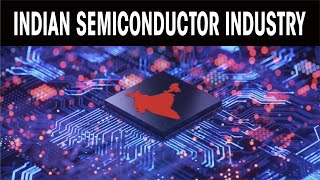The semiconductor industry in India is 100% import driven. Countries exporting semiconductors to India include China, Taiwan, the USA, Japan, etc. India has an advantage of designing chips. India is poised to emerge as a major player in 5G, semiconductor and chip technology, live sports, and AVOD with private deployment networks likely to take off in a big way during 2025-2028, according to Deloitte.
With the introduction of incentive schemes including Design-Linked Incentive, Production-Linked Incentive and others, startups dealing with semiconductor design & manufacturing have started to emerge. Today, over 90% of semiconductor leaders have R&D centres in India.
It has also projected the Indian semiconductor market to be worth $55 billion by 2026.The industry is poised to play an important role in enhancing the global value chain as it will expand to a market size of $85 billion and generate employability for 6,00,000 by 2030.
Satellite broadband and communication service market in India is expected to grow and expand with the developing use case horizon and exponential growth in data consumption, as per Deloitte's 2023 TMT (Technology, Media and Entertainment, Telecom) predictions.
Indian semiconductor Industry.

Semiconductor Plant पर बवाल, Shinde Sarkar पर सवाल | Gujarat क्यों गया Semiconductor Plant ?#dblive
#EknathShinde #Gujarat #SemiconductorPlant #HindiNews | #BreakingNews | #Watch | #video |
Get paid membership : https://www.youtube.com/channel/UCBbpLKJLhIbDd_wX4ubU_Cw/join
DB LIVE APP : https://play.google.com/store/apps/details?id=dblive.tv.news.dblivetv.com
DB LIVE TV : http://dblive.tv/
SUBSCRIBE TO OUR CHANNEL: https://www.youtube.com/channel/UCBbpLKJLhIbDd_wX4ubU_Cw
DESHBANDHU : http://www.deshbandhu.co.in/
FACEBOOK : https://www.facebook.com/DBlivenews/
TWITTER : https://twitter.com/dblive15
ENTERTAINMENT LIVE : https://www.youtube.com/channel/UCyX4qQhpz8WQP2Iu7jzHGFQ
Sports Live : https://www.youtube.com/channel/UCHgCkbxlMRgMrjUtvMmBojg
Semiconductor Plant पर बवाल, Shinde Sarkar पर सवाल | Gujarat क्यों गया Semiconductor Plant ?#dblive
News video | 21054 views

The semiconductor industry in India is 100% import driven. Countries exporting semiconductors to India include China, Taiwan, the USA, Japan, etc. India has an advantage of designing chips. India is poised to emerge as a major player in 5G, semiconductor and chip technology, live sports, and AVOD with private deployment networks likely to take off in a big way during 2025-2028, according to Deloitte.
With the introduction of incentive schemes including Design-Linked Incentive, Production-Linked Incentive and others, startups dealing with semiconductor design & manufacturing have started to emerge. Today, over 90% of semiconductor leaders have R&D centres in India.
It has also projected the Indian semiconductor market to be worth $55 billion by 2026.The industry is poised to play an important role in enhancing the global value chain as it will expand to a market size of $85 billion and generate employability for 6,00,000 by 2030.
Satellite broadband and communication service market in India is expected to grow and expand with the developing use case horizon and exponential growth in data consumption, as per Deloitte's 2023 TMT (Technology, Media and Entertainment, Telecom) predictions.
Indian semiconductor Industry
Technology video | 174 views

Intel co-founder & pioneer in the semiconductor industry Gordon Moore dies at 94 #shortsvideo
Technology video | 203 views

Russia- Ukraine War | Semiconductor Chip Industry | VARINDIA News Hour
#Russia_Ukraine_war #VARINDIA_News_Hour
There is growing tension and bad news for the already-stressed #semiconductor chip industry. This comes at a time when chipmakers are struggling to keep up with the demand for chips across the computing and automobile sectors, among others. Experts predict that the Russia Ukraine war has the potential to constrain the supplies of neon and palladium – two critical components in the manufacturing of semiconductor chips. Ukraine is a major supplier of neon gas, which is used in the lithography stages of chip production. Sources said, Ukraine has a share of 90% semiconductor -grade of neon, a noble gas. The gas, a biproduct of Russian steel manufacturing, is purified in Ukraine, market research firm Techcet says. Russia is the source of 35% of the palladium used in the United States. The metal is used in sensors and memory, among other applications. This could lead to an increase in the cost of production of semiconductor chips. Both Russia and Ukraine are vital exporters of raw materials used in the manufacturing of Chipsets and semiconductors, with these chips being vital to all modern electrical devices, companies may decide to pass on these costs to buyers, leading to an increase in the prices of consumer technology products.
Europe faced one of its biggest security crises in decades, after Russia invaded Ukraine by land, air and sea. As per analysts, Russia is also a key supplier of neon and palladium – accounting for a third of the global supply of the metal. Palladium is a metal that is used for electronics, catalytic converters among other things. West’s sanctions against Russia could lead to a shortage of this metal and force manufacturers to scramble for alternative sources. Large chip companies said they expected limited supply chain disruption for now from the Russia-Ukraine conflict, thanks to raw material stockpiling a
Technology video | 233 views

UCIe technology is expected to bring innovations in semiconductor industry | VARINDIA News Hour
#UCIetechnology #VARINDIA_News_Hour #VARINDIA
The growing concern on the Semiconductor chip shortages have been aggravated by the pandemic. Manufacturing companies are increasing chip production – but the shortfall won't be resolved immediately. With the rising popularity of chiplets in semiconductors, market leaders in packaging, IP suppliers, foundries, and cloud service providers have joined forces to launch the Universal Chiplet Interconnect Express (UCIe) standard to establish an open ecosystem for future technologies. Industry leaders joining the initiative already include the likes of AMD, Intel, Meta, Microsoft, Google, TSMC, Samsung, Arm, and Qualcomm, whereas Nvidia is notably absent from the grouping, despite exploring a chiplet path for its next-generation GPU designs. The UCIe 1.0 specification is a complete standardized die-to-die interconnect, encompassing a physical layer, protocol stack, software model, and compliance testing, a consortium said. It natively maps PCI Express (PCIe) and Compute Express Link (CXL) protocols. The spec will enable end users to mix and match dies and other chiplet components from multiple sources with different packaging options.
According to Gordon Moore, the number of transistors in an integrated circuit doubles every two years (i.e., Moore's Law). However, maintaining this while using a monolithic design has gradually become more challenging, leading companies like AMD and Intel to use chiplet systems within their products. However, as chiplets become the new norm for CPUs and GPUs, developing an industry-wide standard would greatly help the industry, as manufacturing partners could use components from different ecosystems and still create an SoC with them. Besides the modularity it brings, implementing the new standard across the chip industry would also speed up the development of new
Technology video | 226 views

Japan is under great pressure to find solutions to revive its semiconductor industry, as the ongoing chip shortages and high semiconductor supply chain disruption risks remain major challenges for governments around the world. The world’s semiconductor race is accelerating. Used in every electronic appliance essential to our daily lives, semiconductors are critical to national security. Driven by competition between the United States and China, as well as a global chip supply shortage and supply-chain disruptions, governments around the world are pursuing aggressive funding measures to secure access to semiconductors. Japan is no exception – strengthening semiconductor supply chains is a key element of its latest economic security bill. The US is in the final phase of passing the CHIPS Act, which will provide $52 billion to subsidise semiconductor manufacturing. Following the US, in February 2022, the European Commission announced the Chips Act package, a 43 billion Euro investment plan to increase its market share of global production from 10 to 20% by 2030. South Korea is also seeking to pass legislation that would provide $450 billion in investment in semiconductor production over ten years. To develop an effective industry revival strategy, the Japanese government and domestic semiconductor players are now reflecting on why Japan's semiconductor industry has been losing ground to foreign competitors in the global marketplace.
According to Nikkei and Mynavi, the Ministry of Economy, Trade and Industry (METI) of Japan has mentioned potential strategies to revive the country's semiconductor industry in its 'Strategy for Semiconductors and the Digital Industry' released in June last year. Japan has made a three-phase strategy to revive the semiconductor industry. In response to the US-China trade war, governments around the world began pushing for semiconductor localization. Japan's METI has also come up with a three-phase strategy
Technology video | 192 views

#Semiconductors to be the new commodity on which the modern world depends, the Modi government has approved the India Semiconductor Scheme with a financial outlay of Rs 76,000 crore in December 2021.
What many experts were sure of was the fact that the semiconductor industry is poised for a decade of growth and by 2030 it is projected to become a trillion-dollar industry.
Experts predict that the short-term outlook for semiconductor revenue has worsened. Rapid deterioration in the global economy and weakening consumer demand will negatively impact the semiconductor market in 2023.
The World Semiconductor Trade Statistics predicts Japan, the US and Europe to witness growth in 2023, but a 7.5% decline is forecast for the rest of the Asia Pacific region including China, which is the world’s largest semiconductor market and accounts for over 30% of the total.
Currently, the semiconductor market is polarized between the consumer-driven markets and enterprise-driven markets. Global semiconductor revenue is forecast to total $596 billion in 2023, down from the previous forecast of US$623 billion. To boost India's dream of becoming a semiconductor nation, now Power chip Semiconductor Manufacturing Corp is ready to help India in setting fabs.
Taiwan Semiconductor Manufacturing Co. (TCMC) said that it is considering building a second plant in Japan and is evaluating the possibility of a first in Europe as the world's largest contract chipmaker responds to customers’ demands for a more geographically diverse supply chain. TSMC manufactures chips for almost all the world's major chip developers, including Apple, Nvidia, Qualcomm and MediaTek.
India holds over 6 percent of the world’s rare earth reserves, some of which are vital to the production of semiconductors, and Indian companies have been pushing for the government to take advantage of this fact.
With this India has been investing in domestic se
Technology video | 182 views

IT minister says investments from global players to boost India's semiconductor industry #shorts
Technology video | 131 views

Let us salute to the India's Pride- Indian Armed Forces.
The Indian armed forces have been engaged in a number of major military operations, including the Indo-Pakistani wars of 1947, 1965 and 1971, the Portuguese-Indian War, the Sino-Indian War, the 1967 Chola incident, the 1987 Sino-Indian skirmish, the Kargil War, and the Siachen conflict among others. India honours its armed forces and military personnel annually on Armed Forces Flag Day, 7 December.
News video | 7725 views

#Micron announces new semiconductor assembly and test facility in India #shortsvideo
Technology video | 191 views

Bihar में अगला CM तय ! #nitishkumar #tejashwiyadav #laluyadav #prashantkishor #bihar #biharnews #biharpolitics #biharelection #bjp #nda #breakingnews #dblive
Please Subscribe
DB LIVE : https://www.youtube.com/@DBLive
DB LIVE Bihar-Jharkhand : https://www.youtube.com/@DBLiveBiharJharkhand
DB LIVE Maharashtra : https://www.youtube.com/@DBLiveMaharashtra
DB Live Haryana : https://www.youtube.com/@dbliveharyana
DB LIVE Jammu-Kashmir : https://www.youtube.com/@DBLIVEJk
DB LIVE Delhi : https://www.youtube.com/@DBLIVEDelhi
DB LIVE UP-UK : https://www.youtube.com/@DBLIVEupuk
___________________________________________________________________
Get paid membership : https://www.youtube.com/channel/UCBbpLKJLhIbDd_wX4ubU_Cw/join
Like us on Facebook :https://www.facebook.com/dbliveofficial
Follow us on Twitter : https://twitter.com/dblive15
Follow us on Instagram : https://www.instagram.com/dblive.official/
Follow Us On WhatsApp : https://whatsapp.com/channel/0029VaW4v2P0Vyc9Z4j6Cq2i
Visit DB Live website : http://www.dblive.co.in
Visit Deshbandhu website : http://www.deshbandhu.co.in/
DB Live Contact : dblive15@gmail.com
Bihar में अगला CM तय ! Nitish Kumar | Tejashwi Yadav | Bihar Politics | Bihar Election | #dblive
News video | 5384 views

कांग्रेस की बड़ी प्रेस कॉन्फ्रेंस ! Congress Press Conference | Ajay Kumar Lallu| Bhakta Das |#dblive
Please Subscribe
DB LIVE : https://www.youtube.com/@DBLive
DB LIVE Bihar-Jharkhand : https://www.youtube.com/@DBLiveBiharJharkhand
DB LIVE Maharashtra : https://www.youtube.com/@DBLiveMaharashtra
DB Live Haryana : https://www.youtube.com/@dbliveharyana
DB LIVE Jammu-Kashmir : https://www.youtube.com/@DBLIVEJk
DB LIVE Delhi : https://www.youtube.com/@DBLIVEDelhi
DB LIVE UP-UK : https://www.youtube.com/@DBLIVEupuk
___________________________________________________________________
Get paid membership : https://www.youtube.com/channel/UCBbpLKJLhIbDd_wX4ubU_Cw/join
Like us on Facebook :https://www.facebook.com/dbliveofficial
Follow us on Twitter : https://twitter.com/dblive15
Follow us on Instagram : https://www.instagram.com/dblive.official/
Follow Us On WhatsApp : https://whatsapp.com/channel/0029VaW4v2P0Vyc9Z4j6Cq2i
Visit DB Live website : http://www.dblive.co.in
Visit Deshbandhu website : http://www.deshbandhu.co.in/
DB Live Contact : dblive15@gmail.com
कांग्रेस की बड़ी प्रेस कॉन्फ्रेंस ! Congress Press Conference | Ajay Kumar Lallu| Bhakta Das |#dblive
News video | 2001 views

Rahul का मिशन गुजरात, घबराकर Modi भी पहुंचे, Pegasus पर SC में घिरी सरकार ! #pegasus #congress #bjp #rahulgandhi #modi #election #yogiadityanath #sambhalnews #dblive
Please Subscribe
DB LIVE : https://www.youtube.com/@DBLive
DB LIVE Bihar-Jharkhand : https://www.youtube.com/@DBLiveBiharJharkhand
DB LIVE Maharashtra : https://www.youtube.com/@DBLiveMaharashtra
DB Live Haryana : https://www.youtube.com/@dbliveharyana
DB LIVE Jammu-Kashmir : https://www.youtube.com/@DBLIVEJk
DB LIVE Delhi : https://www.youtube.com/@DBLIVEDelhi
DB LIVE UP-UK : https://www.youtube.com/@DBLIVEupuk
___________________________________________________________________
Get paid membership : https://www.youtube.com/channel/UCBbpLKJLhIbDd_wX4ubU_Cw/join
Like us on Facebook :https://www.facebook.com/dbliveofficial
Follow us on Twitter : https://twitter.com/dblive15
Follow us on Instagram : https://www.instagram.com/dblive.official/
Follow Us On WhatsApp : https://whatsapp.com/channel/0029VaW4v2P0Vyc9Z4j6Cq2i
Visit DB Live website : http://www.dblive.co.in
Visit Deshbandhu website : http://www.deshbandhu.co.in/
DB Live Contact : dblive15@gmail.com
#DBLiveBreaking :Rahul का मिशन गुजरात, घबराकर Modi भी पहुंचे, Pegasus पर SC में घिरी सरकार ! #dblive
News video | 2017 views

Maharashtra-Bihar बने BJP के लिए बड़ी मुसीबत | Rahul Gandhi | PM modi | Nitish Kumar | #dblive #NewsPoint
Please Subscribe
DB LIVE : https://www.youtube.com/@DBLive
DB LIVE Bihar-Jharkhand : https://www.youtube.com/@DBLiveBiharJharkhand
DB LIVE Maharashtra : https://www.youtube.com/@DBLiveMaharashtra
DB Live Haryana : https://www.youtube.com/@dbliveharyana
DB LIVE Jammu-Kashmir : https://www.youtube.com/@DBLIVEJk
DB LIVE Delhi : https://www.youtube.com/@DBLIVEDelhi
DB LIVE UP-UK : https://www.youtube.com/@DBLIVEupuk
___________________________________________________________________
Get paid membership : https://www.youtube.com/channel/UCBbpLKJLhIbDd_wX4ubU_Cw/join
Like us on Facebook :https://www.facebook.com/dbliveofficial
Follow us on Twitter : https://twitter.com/dblive15
Follow us on Instagram : https://www.instagram.com/dblive.official/
Follow Us On WhatsApp : https://whatsapp.com/channel/0029VaW4v2P0Vyc9Z4j6Cq2i
Visit DB Live website : http://www.dblive.co.in
Visit Deshbandhu website : http://www.deshbandhu.co.in/
DB Live Contact : dblive15@gmail.com
Maharashtra-Bihar बने BJP के लिए बड़ी मुसीबत | Rahul Gandhi | PM modi | Nitish Kumar | #dblive News
News video | 1886 views

औरंगज़ेब पर NDA में दरार.. फ़ड़नवीस-शिंदे में टकराव के बीच अचानक मुंबई पंहुचे Rahul Gandhi |#dblive
Please Subscribe
DB LIVE : https://www.youtube.com/@DBLive
DB LIVE Bihar-Jharkhand : https://www.youtube.com/@DBLiveBiharJharkhand
DB LIVE Maharashtra : https://www.youtube.com/@DBLiveMaharashtra
DB Live Haryana : https://www.youtube.com/@dbliveharyana
DB LIVE Jammu-Kashmir : https://www.youtube.com/@DBLIVEJk
DB LIVE Delhi : https://www.youtube.com/@DBLIVEDelhi
DB LIVE UP-UK : https://www.youtube.com/@DBLIVEupuk
___________________________________________________________________
Get paid membership : https://www.youtube.com/channel/UCBbpLKJLhIbDd_wX4ubU_Cw/join
Like us on Facebook :https://www.facebook.com/dbliveofficial
Follow us on Twitter : https://twitter.com/dblive15
Follow us on Instagram : https://www.instagram.com/dblive.official/
Follow Us On WhatsApp : https://whatsapp.com/channel/0029VaW4v2P0Vyc9Z4j6Cq2i
Visit DB Live website : http://www.dblive.co.in
Visit Deshbandhu website : http://www.deshbandhu.co.in/
DB Live Contact : dblive15@gmail.com
औरंगज़ेब पर NDA में दरार.. फ़ड़नवीस-शिंदे में टकराव के बीच अचानक मुंबई पंहुचे Rahul Gandhi |#dblive
News video | 1866 views

मोदी से टूटा संघ का भरोसा Bihar में संभाली कमान | Nitish Kumar | Mohan Bhagwat | Tejashwi |#dblive
Please Subscribe
DB LIVE : https://www.youtube.com/@DBLive
DB LIVE Bihar-Jharkhand : https://www.youtube.com/@DBLiveBiharJharkhand
DB LIVE Maharashtra : https://www.youtube.com/@DBLiveMaharashtra
DB Live Haryana : https://www.youtube.com/@dbliveharyana
DB LIVE Jammu-Kashmir : https://www.youtube.com/@DBLIVEJk
DB LIVE Delhi : https://www.youtube.com/@DBLIVEDelhi
DB LIVE UP-UK : https://www.youtube.com/@DBLIVEupuk
___________________________________________________________________
Get paid membership : https://www.youtube.com/channel/UCBbpLKJLhIbDd_wX4ubU_Cw/join
Like us on Facebook :https://www.facebook.com/dbliveofficial
Follow us on Twitter : https://twitter.com/dblive15
Follow us on Instagram : https://www.instagram.com/dblive.official/
Follow Us On WhatsApp : https://whatsapp.com/channel/0029VaW4v2P0Vyc9Z4j6Cq2i
Visit DB Live website : http://www.dblive.co.in
Visit Deshbandhu website : http://www.deshbandhu.co.in/
DB Live Contact : dblive15@gmail.com
मोदी से टूटा संघ का भरोसा Bihar में संभाली कमान | Nitish Kumar | Mohan Bhagwat | Tejashwi |#dblive
News video | 1879 views

Join Our Bartending School The Spirit Vidyalaya, Call us on 7558204535
Check out our website - www.cocktailsindia.com
Check out my Podcast - 'Dada Bartender Podcast' https://open.spotify.com/show/0ub0ll4SUUWwHDo5qk5Nb5?si=7b3ac81e1c194caf
Please follow me on Instagram: https://www.instagram.com/cocktailsindia2016/
Instagram (2): www.instagram.com/dada.bartender
Please follow me on Facebook: https://www.facebook.com/profile.php?id=100092566239501&mibextid=LQQJ4d
For Business / Suggestion: dada@cocktailsindia.com
sponsor.cocktailsindia@gmail.com
Affiliate Link
********************************************************************
My Camera - Canon EOS 200D II - Link To Purchase - https://amzn.to/3ZXuNQD
My Best Camera - Sony A7 3 - https://amzn.to/3ZjAkAJ
My Sound - GODOX MoveLink M2 - https://amzn.to/3JcqaMJ
My Light setup - GODOX LC500R RGB LED Light Stick - https://amzn.to/3SQmu6P
My Lens Setup - Sigma 18-35mm f/1.8 DC for Canon - https://amzn.to/3ZDqbyD
My Lens Setup - Canon EF50MM F/1.8 STM Lens - https://amzn.to/41CEeX4
My Audio Setup - Zoom H1n Handy Recorder - https://amzn.to/3mudhFa
Home Bar Accessories - https://amzn.to/3LedEOv
Glassware - https://amzn.to/3KRPSrf
Ice mould - https://amzn.to/3EWlecr
Disclaimer:
The purpose of this channel is not to support or encourage underage drinking but to provide knowledge of the products we consume. This channel does not promote or sell any alcoholic product. The purpose of this channel is to strictly entertain and inform people about products available on the market. We are strictly against underage drinking and do not support it.
About The Channel:-
If you love homestyle cocktails, reviews of Alcohol, Drink knowledge, Bartending and many more then this channel is for you. India is the biggest alcohol consumer in the world. We buy and consume more whiskey in the worl
Cooking video | 15543 views

Kolkata’s Best Bartending School with LAB Felicity “The Spirit Vidyalaya”. If you love bartending then come and join us
Please call Sourav +91 755-8204535 for further dissertation. Thanks
What My Students Speaking? About My Bartending School “The Spirit Vidyalaya” Kolkata
Cooking video | 3438 views

PEG क्या है, इसे PEG क्यों कहा जाता है? | What Is Peg
Join Our Bartending School The Spirit Vidyalaya, Call us on 7558204535
Check out our website - www.cocktailsindia.com
Check out my Podcast - 'Dada Bartender Podcast' https://open.spotify.com/show/0ub0ll4SUUWwHDo5qk5Nb5?si=7b3ac81e1c194caf
Please follow me on Instagram: https://www.instagram.com/cocktailsindia2016/
Instagram (2): www.instagram.com/dada.bartender
Please follow me on Facebook: https://www.facebook.com/profile.php?id=100092566239501&mibextid=LQQJ4d
For Business / Suggestion: dada@cocktailsindia.com
sponsor.cocktailsindia@gmail.com
Affiliate Link
********************************************************************
My Camera - Canon EOS 200D II - Link To Purchase - https://amzn.to/3ZXuNQD
My Best Camera - Sony A7 3 - https://amzn.to/3ZjAkAJ
My Sound - GODOX MoveLink M2 - https://amzn.to/3JcqaMJ
My Light setup - GODOX LC500R RGB LED Light Stick - https://amzn.to/3SQmu6P
My Lens Setup - Sigma 18-35mm f/1.8 DC for Canon - https://amzn.to/3ZDqbyD
My Lens Setup - Canon EF50MM F/1.8 STM Lens - https://amzn.to/41CEeX4
My Audio Setup - Zoom H1n Handy Recorder - https://amzn.to/3mudhFa
Home Bar Accessories - https://amzn.to/3LedEOv
Glassware - https://amzn.to/3KRPSrf
Ice mould - https://amzn.to/3EWlecr
Disclaimer:
The purpose of this channel is not to support or encourage underage drinking but to provide knowledge of the products we consume. This channel does not promote or sell any alcoholic product. The purpose of this channel is to strictly entertain and inform people about products available on the market. We are strictly against underage drinking and do not support it.
About The Channel:-
If you love homestyle cocktails, reviews of Alcohol, Drink knowledge, Bartending and many more then this channel is for you. India is the biggest alcohol con
Cooking video | 3303 views

What is Wheat Beer? | व्हीट बीयर क्या है?
Join Our Bartending School The Spirit Vidyalaya, Call us on 7558204535
Check out our website - www.cocktailsindia.com
Check out my Podcast - 'Dada Bartender Podcast' https://open.spotify.com/show/0ub0ll4SUUWwHDo5qk5Nb5?si=7b3ac81e1c194caf
Please follow me on Instagram: https://www.instagram.com/cocktailsindia2016/
Instagram (2): www.instagram.com/dada.bartender
Please follow me on Facebook: https://www.facebook.com/profile.php?id=100092566239501&mibextid=LQQJ4d
For Business / Suggestion: dada@cocktailsindia.com
sponsor.cocktailsindia@gmail.com
Affiliate Link
********************************************************************
My Camera - Canon EOS 200D II - Link To Purchase - https://amzn.to/3ZXuNQD
My Best Camera - Sony A7 3 - https://amzn.to/3ZjAkAJ
My Sound - GODOX MoveLink M2 - https://amzn.to/3JcqaMJ
My Light setup - GODOX LC500R RGB LED Light Stick - https://amzn.to/3SQmu6P
My Lens Setup - Sigma 18-35mm f/1.8 DC for Canon - https://amzn.to/3ZDqbyD
My Lens Setup - Canon EF50MM F/1.8 STM Lens - https://amzn.to/41CEeX4
My Audio Setup - Zoom H1n Handy Recorder - https://amzn.to/3mudhFa
Home Bar Accessories - https://amzn.to/3LedEOv
Glassware - https://amzn.to/3KRPSrf
Ice mould - https://amzn.to/3EWlecr
Disclaimer:
The purpose of this channel is not to support or encourage underage drinking but to provide knowledge of the products we consume. This channel does not promote or sell any alcoholic product. The purpose of this channel is to strictly entertain and inform people about products available on the market. We are strictly against underage drinking and do not support it.
About The Channel:-
If you love homestyle cocktails, reviews of Alcohol, Drink knowledge, Bartending and many more then this channel is for you. India is the biggest alcohol consumer in th
Cooking video | 3092 views

भारत में पहला BAR कौन सा है? Which is the First BAR in India? Do you know?
#firstbar #Indiasfirstbar #bar #cocktailsindia
Check out my Podcast - 'Dada Bartender Podcast' https://open.spotify.com/show/0ub0ll4SUUWwHDo5qk5Nb5?si=7b3ac81e1c194caf
Please follow me on Instagram: https://www.instagram.com/cocktailsindia2016/
Please follow me on Facebook: https://www.facebook.com/cocktailsindia1975/
For Business / Suggestion: sponsor.cocktailsindia@gmail.com
Affiliate Link
********************************************************************
My Camera - Canon EOS 200D II - Link To Purchase - https://amzn.to/3ZXuNQD
My Best Camera - Sony A7 3 - https://amzn.to/3ZjAkAJ
My Sound - GODOX MoveLink M2 - https://amzn.to/3JcqaMJ
My Light setup - GODOX LC500R RGB LED Light Stick - https://amzn.to/3SQmu6P
My Lens Setup - Sigma 18-35mm f/1.8 DC for Canon - https://amzn.to/3ZDqbyD
My Lens Setup - Canon EF50MM F/1.8 STM Lens - https://amzn.to/41CEeX4
My Audio Setup - Zoom H1n Handy Recorder - https://amzn.to/3mudhFa
Home Bar Accessories - https://amzn.to/3LedEOv
Glassware - https://amzn.to/3KRPSrf
Ice mould - https://amzn.to/3EWlecr
Disclaimer:
The purpose of this channel is not to support or encourage underage drinking but to provide knowledge of the products we consume. This channel does not promote or sell any alcoholic product. The purpose of this channel is to strictly entertain and inform people about products available on the market. We are strictly against underage drinking and do not support it.
About The Channel:-
If you love homestyle cocktails, reviews of Alcohol, Drink knowledge, Bartending and many more then this channel is for you. India is the biggest alcohol consumer in the world. We buy and consume more whiskey in the world than anyone else. This channel helps give information about your favorite drink. How to make fantastic cocktails at ho
Cooking video | 3016 views

एक Wine की बोतल की सेल्फ लाइफ क्या होती है? What is the shelf-life of a bottle of wine?
#wine #Wineshelflife #cocktailsindia #dadabartender
Join Our Bartending School The Spirit Vidyalaya, Call us on 7558204535
Check out our website - www.cocktailsindia.com
Check out my Podcast - 'Dada Bartender Podcast' https://open.spotify.com/show/0ub0ll4SUUWwHDo5qk5Nb5?si=7b3ac81e1c194caf
Please follow me on Instagram: https://www.instagram.com/cocktailsindia2016/
Instagram (2): www.instagram.com/dada.bartender
Please follow me on Facebook: https://www.facebook.com/profile.php?id=100092566239501&mibextid=LQQJ4d
For Business / Suggestion: dada@cocktailsindia.com
sponsor.cocktailsindia@gmail.com
Affiliate Link
********************************************************************
My Camera - Canon EOS 200D II - Link To Purchase - https://amzn.to/3ZXuNQD
My Best Camera - Sony A7 3 - https://amzn.to/3ZjAkAJ
My Sound - GODOX MoveLink M2 - https://amzn.to/3JcqaMJ
My Light setup - GODOX LC500R RGB LED Light Stick - https://amzn.to/3SQmu6P
My Lens Setup - Sigma 18-35mm f/1.8 DC for Canon - https://amzn.to/3ZDqbyD
My Lens Setup - Canon EF50MM F/1.8 STM Lens - https://amzn.to/41CEeX4
My Audio Setup - Zoom H1n Handy Recorder - https://amzn.to/3mudhFa
Home Bar Accessories - https://amzn.to/3LedEOv
Glassware - https://amzn.to/3KRPSrf
Ice mould - https://amzn.to/3EWlecr
Disclaimer:
The purpose of this channel is not to support or encourage underage drinking but to provide knowledge of the products we consume. This channel does not promote or sell any alcoholic product. The purpose of this channel is to strictly entertain and inform people about products available on the market. We are strictly against underage drinking and do not support it.
About The Channel:-
If you love homestyle cocktails, reviews of Alcohol, Drink kn
Cooking video | 3062 views